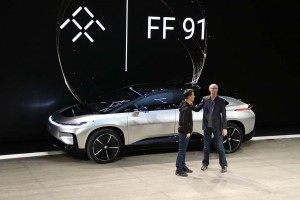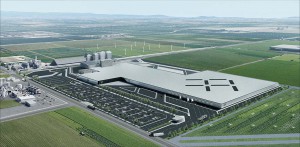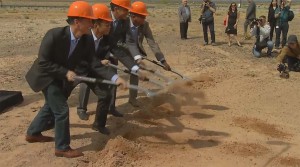Reports of Faraday Future’s demise, as Mark Twain might have suggested, have been greatly exaggerated. Or so the Chinese-funded battery-carmaker wants us to believe.
Faraday has seemed on the verge of extinction for some time, “temporarily” halting work on its $1 billion Nevada assembly plant last year and then, barely a month ago walking away from the project entirely.
But Faraday on Monday announced it has lined up a new factory to produce the FF91 battery-electric vehicle, or BEV, it unveiled in January. The new site is a one-time Pirelli tire plant in Hanford, California that has largely sat idle since 2001.
(Faraday cuts and runs out on its unfinished Nevada plant. Click Here for the story.)
“We know there is a lot of work and risks ahead, but this event represents a major step forward for the company,” said Stefan Krause, COO/CFO, Faraday Future, as 300 of the company’s employees drove to the facility to begin the process of cleaning it up.
“As we begin this next phase in our company’s history,” Krause added, “our efforts to build out strong corporate leadership will bring a new focus to Faraday Future and deliver on our commitments to employees, investors, suppliers, and future users, who have shown exceptional patience and resilience through the company’s difficult times.”
Faraday has had something of a roller-coaster existence since it went public in 2015. It has made some headline-grabbing moves with the debut of an early prototype and, at the Consumer Electronics Show last January, the debut of the FF91, slated to be its first production model.
In late 2015, it said it would invest $1 billion in a plant on the outskirts of Las Vegas, but within months of breaking ground it became apparent the company was facing serious financial challenges due, in large part to the problems faced by key backer Jia Yueting, the high-tech billionaire some have called “China’s Steve Jobs.” The delay was supposed to be a “temporary adjustment,” but it triggered plenty of skepticism and a scolding by a senior official for the State of Nevada, which coughed up substantial public assistance for the project.
“This is a Ponzi scheme,” Nevada State Treasures Dan Schwartz told the Reuters wire service. “You have a new company that has never built a car, building a new plant in the middle of the desert, financed by a mysterious Chinese billionaire. At some point, as with Bernie Madoff, the game ends.”
When the company announced last month it was killing the Nevada project it insisted it had a less expensive alternative in mind. There have been no details on what Faraday is paying for the facility, nor has FF said how much it will cost to bring it into production. But Dag Reckhorn, the VP of Global Manufacturing said the move is a “demonstration of our commitment to getting FF 91 on the road by the end of 2018,” the original target date.
The Hanford facility is located about 200 miles north of Los Angeles, or a little more than halfway up towards Silicon Valley. Arch-rival Tesla operates its factory in the San Francisco suburb of Fremont. The plant was original set up by the Armstrong Rubber Co. and then sold to Italy’s Pirelli in 1985. It moved its operations to South America in 2001 and shut the Hanford plant down, a financial shock to the community of 55,000.
Since then, it has largely gone unused, though the city was considering a proposal to turn it into a medical marijuana farm and processing plant.
Faraday said it expects to employ as many as 1,500 U.S. workers once the FF91 is up and running. It is expected to use as much as 800,000 square feet of the 1 mil sq-ft facility.
(Lucid reportedly talks to Ford about takeover. Click Here for more on that battery-car start-up’s challenges.)
But there are plenty of skeptics. While the company did get a $14 million bridge loan, according to the Wall Street Journal, enough to put a deposit down on the plant, it had to put up its L.A. headquarters as collateral. And it is still struggling to raise more cash with Jia’s own fortune tied up. (That has also hurt a second battery-car start-up, LeEco, that the Chinese entrepreneur was backing.)
While Krause said, “our employees continue to be Faraday Future’s strongest asset,” that is another asset giving the company trouble, as a number of employees have left during the last year’s financial turmoils.
If it can pull things together, Faraday says the FF91 will be the first of several products it plans to bring to market, like Tesla, the company initially focusing on a halo vehicle that will launch from 0 to 60 in little more than 2 seconds, provide over 300 miles range and also offer what the company claims will be fully autonomous driving capabilities.
(LeEco pulls out of EV sports car program with Aston Martin. Click Here for the story.)




